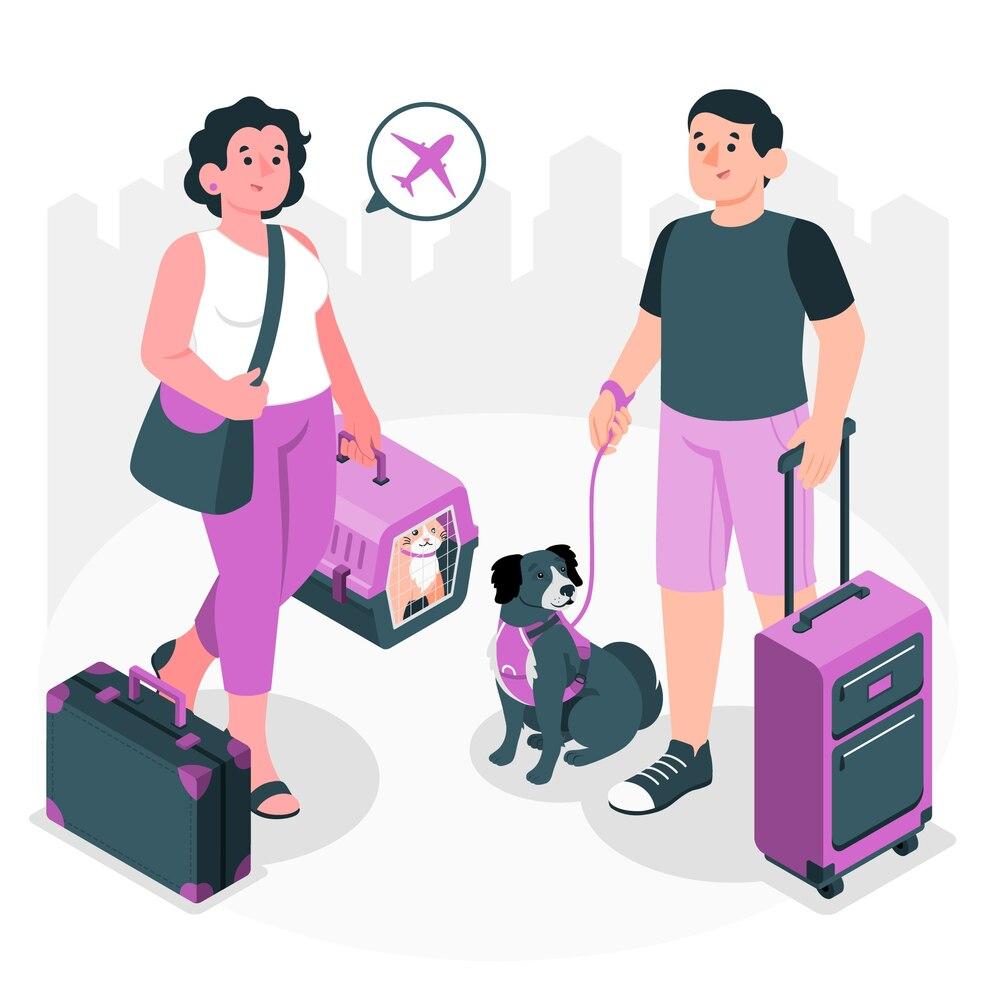Whether you’re relocating across the country or planning an extended vacation, traveling long distances with your pet requires careful planning. Animals experience travel differently than humans do, and without proper preparation, the journey can cause unnecessary stress and health risks for your furry companion.
Understanding how to prepare your pet for long-distance travel involves addressing various aspects of your pet’s physical and emotional wellbeing before, during, and after the journey. This preparation is especially crucial for pets who are not accustomed to traveling or those with existing health conditions.
How to Prepare Your Pet for Long-Distance Travel in 2025
1. Pre-Travel Veterinary Checkups: The Essential First Step
Before embarking on any long-distance journey with your pet, scheduling a comprehensive veterinary examination is crucial.
Health Certificate Requirements
Many states and all international destinations require a health certificate issued within a specific timeframe before travel. During this visit, your veterinarian will:
- Conduct a thorough physical examination
- Ensure vaccinations are up-to-date
- Provide necessary documentation for travel
- Discuss any destination-specific health concerns
Medication Considerations
Your veterinarian can also advise on how to prepare your pet for long-distance travel regarding medications:
- Refill prescriptions for existing conditions
- Discuss whether mild sedatives are appropriate (not recommended for air travel)
- Provide preventative medications for motion sickness
- Recommend natural calming supplements if needed
RECOMMENDED
- How to Travel With Your Dog: Complete Guide for 2025
- Professional Pet Laundry vs DIY in Nigeria: Why Experts Deliver Superior Results
- How to Choose the Right Pet Laundry Service in Nigeria: Key Factors to Consider
2. Crate Training: Creating a Safe Space for Travel
Whether traveling by car or plane, a properly-sized travel crate is essential for your pet’s safety and comfort.
Selecting the Right Crate
When learning how to prepare your pet for long-distance travel, choosing the appropriate crate is crucial:
- Ensure the crate is large enough for your pet to stand, turn around, and lie down comfortably
- For air travel, verify the crate meets airline-specific requirements
- Consider crash-tested crates for car travel for maximum safety
- Choose crates with proper ventilation on multiple sides
Acclimation Process
Introducing your pet to their travel crate well in advance of your journey:
- Place familiar bedding and toys inside to create positive associations
- Begin with short periods in the crate, gradually increasing duration
- Practice car rides of increasing length to help your pet adjust
- Reward calm behavior in the crate with treats and praise
3. Identification and Tracking: Preventing the Worst-Case Scenario
Knowing how to prepare your pet for long-distance travel includes taking precautions against the possibility of separation.
Updated Identification
Ensure your pet has multiple forms of identification:
- Microchip with current contact information
- Collar with ID tags displaying your phone number
- Temporary travel tag with destination information
- Bright-colored collar for visibility
GPS Tracking Options
For additional peace of mind, consider:
- GPS-enabled pet collars
- Bluetooth tracking devices that attach to your pet’s collar
- Apps that connect to these devices to monitor location
4. Packing Essentials: What to Bring for Your Pet
Creating a comprehensive packing list is a key component of how to prepare your pet for long-distance travel:
Food and Water Supplies
- Sufficient food for the entire journey plus extra for delays
- Collapsible food and water bowls
- Bottled water to avoid stomach upset from unfamiliar water sources
- Familiar treats for comfort and rewards
Comfort Items
- Bedding with familiar scents
- Favorite toys (avoid noisy ones in public transportation)
- An item of clothing with your scent
- Blanket to cover the crate if needed
Emergency Kit
- First aid supplies specific to pets
- List of emergency veterinary contacts along your route
- Copies of medical records and prescriptions
- Recent photo of your pet for identification purposes
5. Mode-Specific Considerations: Air, Car, and Train Travel
How to prepare your pet for long-distance travel varies depending on your transportation method:
Air Travel Preparation
- Book direct flights whenever possible
- Verify airline pet policies and crate requirements
- Consider temperature restrictions that may affect travel dates
- Request a cabin position with regulated temperature if traveling in cargo
- Exercise your pet thoroughly before check-in
Car Travel Tips
- Secure the crate or use a pet seat belt harness
- Plan for regular breaks (every 2-3 hours) for elimination and exercise
- Never leave your pet unattended in a parked vehicle
- Consider window shades for temperature control
- Plan your route with pet-friendly accommodations
Train Travel Considerations
- Verify the train service allows pets and understand their policies
- Consider a pet carrier that fits under the seat if required
- Book a private compartment when available for more space and privacy
- Bring cleanup supplies for accidents
6. Acclimation Strategies: Reducing Travel Anxiety
Understanding how to prepare your pet for long-distance travel includes addressing anxiety before it becomes problematic:
Behavior Modification Techniques
- Practice short car rides with positive reinforcement
- Use pheromone sprays or diffusers designed to calm pets
- Gradually increase time spent in travel scenarios
- Maintain calm energy when preparing for travel
Exercise Before Departure
- Provide ample physical activity before the journey
- Mental stimulation through games or training
- Allow time for elimination before confinement
- Tired pets are generally calmer travelers
Special Travel Considerations for Different Pets
How to prepare your pet for long-distance travel varies by species:
Cats
- Extra focus on crate acclimation as cats are typically less accustomed to travel
- Familiar bedding and hiding spots within the carrier
- Consider portable litter box for longer journeys
- Feliway spray for anxiety reduction
Small Dogs
- Carrier that allows them to be placed under seats on planes
- Extra padding for comfort as they may be more sensitive to bumpy rides
- Frequent hydration opportunities as small dogs can dehydrate quickly
Large Dogs
- Proper exercise regimen before travel to reduce excess energy
- Larger crates that meet transportation requirements
- Elevated food bowls to prevent spillage during travel
Arrival Considerations: Helping Your Pet Adjust
The final aspect of how to prepare your pet for long-distance travel involves planning for your arrival:
Creating Familiarity
- Set up a dedicated space with familiar items immediately upon arrival
- Maintain regular feeding and exercise schedules
- Gradually introduce your pet to new surroundings
- Provide extra attention and reassurance during the adjustment period
Monitoring for Stress
- Watch for signs of travel-related stress or illness
- Know the location of the nearest veterinary clinic
- Allow decompression time before introducing new experiences
- Maintain consistency in rules and boundaries
Successful Long-Distance Travel with Your Pet
Learning how to prepare your pet for long-distance travel requires time, patience, and attention to detail. By following these expert tips, you can significantly reduce travel-related stress for both you and your pet, ensuring a safe and comfortable journey regardless of distance.
Remember that each pet is unique, and what works for one may not work for another. Pay attention to your pet’s specific needs and behaviors, and be willing to adjust your plans accordingly. With proper preparation, traveling with your pet can be an enriching experience that strengthens your bond rather than a stressful ordeal.
At Dulham Veterinary Clinic, we understand how much your pet means to you—especially when they’re part of your travel plans. That’s why we’re here to offer expert guidance on how to travel with your pet safely and comfortably in Nigeria and beyond. From personalized travel tips to vaccination prep and documentation support, our team is dedicated to making your journeys together stress-free. Reach out to us today, and let’s help you and your furry companion explore the world with confidence and care.
Visit Us
No 23 Crown Court Estate 2, Orunbe Close, Oniru, Victoria Island, Lagos.
Phone Us
0806 632 9826
Mail Us
Frequently Asked Questions (FAQs) on How to Travel With Your Pet
1. Can I take my pet on a plane in 2025?
Yes, many airlines now allow dogs to fly, especially small breeds that fit under the seat in a carrier. In 2025, most domestic flights permit dogs under 20 pounds in-cabin, while larger breeds may need to travel in the climate-controlled cargo hold. Some airlines also have pet-only travel services. Always check airline-specific policies and book early, as flights often have pet quotas.
2. What documents do I need to travel with my pet?
You’ll typically need:
- An updated vaccination record (rabies is mandatory)
- A health certificate issued by a vet within 10 days of travel
- Microchipping proof (especially for international travel)
- In 2025, many countries accept a Digital Pet Passport, which stores health records electronically for easy verification at checkpoints.
3. How do I keep my pet calm during travel?
To keep your dog relaxed:
- Crate train them well before the trip
- Use comfort items like their favorite blanket or toy
- Try natural calming aids or vet-approved medications if needed
- Apps like PetCalm offer travel desensitization exercises
- Take frequent breaks on road trips and avoid overstimulation
- 4. Are hotels and rentals pet-friendly?
- Yes, more places than ever in 2025 welcome pets. Major hotel chains have dedicated pet programs offering dog beds, bowls, and even treats. Vacation rentals (via Airbnb or VRBO) often list fenced yards and pet amenities. Use apps like BringFido or PawStay to filter for pet-friendly lodging and read reviews from fellow dog owners.

